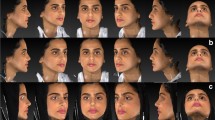Abstract
Objective
The objective of this study was to quantify the use of computer imaging by facial plastic surgeons.
Methods
AAFPRS Facial plastic surgeons were surveyed about their use of computer imaging during rhinoplasty consultations. The survey collected information about surgeon demographics, practice settings, practice patterns, and rates of computer imaging (CI) for primary and revision rhinoplasty. For those surgeons who used CI, additional information was also collected, which included who performed the imaging and whether the patient was given the morphed images after the consultation.
Results
A total of 238 out of 1200 (19.8%) facial plastic surgeons responded to the survey. Out of those who responded, 195 surgeons (83%) were board certified by the American Board of Facial Plastic and Reconstructive Surgeons (ABFPRS). The majority of respondents (150 surgeons, 63%) used CI during rhinoplasty consultation. Of the surgeons who use CI, 92% performed the image morphing themselves. Approximately two-thirds of surgeons who use CI gave their patient a printout of the morphed images after the consultation.
Conclusions
Computer imaging (CI) is a frequently utilized tool for facial plastic surgeons during cosmetic consultations with patients. Based on these results of this study, it can be suggested that the majority of facial plastic surgeons who use CI do so for both primary and revision rhinoplasty. As more sophisticated systems become available, it is possible that utilization of CI modalities will increase. This provides the surgeon with further tools to use at his or her disposal during discussion of aesthetic surgery.
Level of Evidence V
This journal requires that authors assign a level of evidence to each article. For a full description of these Evidence-Based Medicine ratings, please refer to the Table of Contents or the online Instructions to Authors www.springer.com/00266.


Similar content being viewed by others
References
Hilger PA, Webster RC, Hilger JA, Smith RC (1983) A computerized nasal analysis system. Arch Otolaryngol Head Neck Surg 109:653–661
Larrabee W, Maupin G, Sutton D (1985) Profile analysis in facial plastic surgery. Arch Otolaryngol Head Neck Surg 111(10):682–687
Lekakis G, Claes P, Hamilton GS, Hellings PW (2016) Evolution of preoperative rhinoplasty consult by computer imaging. Facial Plast Surg 32(1):80–87
Larrosa F, Dura MJ, Roura J, Hernandez A (2013) Rhinoplasty planning with an iPhone app: analysis of otolaryngologists response. Eur Arch Otorhinolaryngol 270(9):2473–2477
Bronz G (1994) Predictability of the computer imaging system in primary rhinoplasty. Aesthet Plast Surg 18(2):175–181
Toriumi DM, Dixon TK (2011) Assessment of rhinoplasty techniques by overlay of before-and-after 3D images. Facial Plast Surg Clin N Am 19(4):711–23–ix
Agarwal A, Gracely E, Silver WE (2007) Realistic expectations: to morph or not to morph? Plast Reconstr Surg 119(4):1343–1351
Bronz G (1999) The role of the computer imaging system in modern aesthetic plastic surgery. Aesthet Plast Surg 23(3):159–163
Punthakee X, Rival R, Solomon P (2009) Digital imaging in rhinoplasty. Aesthet Plast Surg 33(4):635–638
Adelson RT, DeFatta RJ, Bassischis BA (2008) Objective assessment of the accuracy of computer-simulated imaging in rhinoplasty. Am J Otolaryngol 29(3):151–155
Meruane M, Ayala MF, García-Huidobro MA, Andrades P (2015) Reliability of nasofacial analysis using Rhinobase® Software. Aesthet Plast Surg 40(1):149–156
Weissler JM, Stern CS, Schreiber J, Amirlak B, Tepper OM (2017) The evolution of photography and three-dimensional imaging in plastic surgery. Plast Reconstr Surg 139(3):761–769
Sharp HR, Tingay RS, Coman S, Mills V, Roberts DN (2002) Computer imaging and patient satisfaction in rhinoplasty surgery. J Laryngol Otol 116(12):1009–1013
Cingi CC, Cingi C, Bayar Muluk N (2014) Cingi Steps for preoperative computer-assisted image editing before reduction rhinoplasty. Int Forum Allerg Rhinol 4(4):329–332
Mühlbauer W, Holm C (2005) Computer imaging and surgical reality in aesthetic rhinoplasty. Plast Reconstr Surg 115(7):2098–2104
Chavez AE, Dagum P, Koch J, Newman J (2012) Legal Issues of computer imaging in plastic surgery: a primer. Plast Reconstr Surg 100(6):1601–1608
Bhattacharya S (2008) Jacques Joseph: father of modern aesthetic surgery. Indian J Plast Surg 41(Suppl):S3–S8
Tzou C-HJ, Frey M (2011) Evolution of 3D surface imaging systems in facial plastic surgery. Facial Plast Surg Clin N Am 19(4):591–602–vii
Codazzi D, Bruschi S, Mazzola RF, Bocchiotti MA, Bogetti P, Ortelli L et al (2016) Bergamo 3D Rhinoplasty Software: select, store, and share surgical maneuvers in a three-dimensional nasal model. Plast Reconstr Surg 137(2):313e–317e
Kiranantawat K, Nguyen AH (2015) Asian rhinoplasty: preoperative simulation and planning using Adobe Photoshop. Semin Plast Surg 29(4):232–246
Tzou C-HJ, Artner NM, Pona I, Hold A, Placheta E, Kropatsch WG et al (2014) Comparison of three-dimensional surface-imaging systems. J Plast Reconstr Aesthet Surg 67(4):489–497
Meningaud J-P, Lantieri L, Bertrand J-C (2008) Rhinoplasty: an outcome research. Plast Reconstr Surg 121(1):251–257
Author information
Authors and Affiliations
Corresponding author
Ethics declarations
Conflict of interest
The authors have no conflict of interest to disclose.
Rights and permissions
About this article
Cite this article
Singh, P., Pearlman, S. Use of Computer Imaging in Rhinoplasty: A Survey of the Practices of Facial Plastic Surgeons. Aesth Plast Surg 41, 898–904 (2017). https://doi.org/10.1007/s00266-017-0858-3
Received:
Accepted:
Published:
Issue Date:
DOI: https://doi.org/10.1007/s00266-017-0858-3




